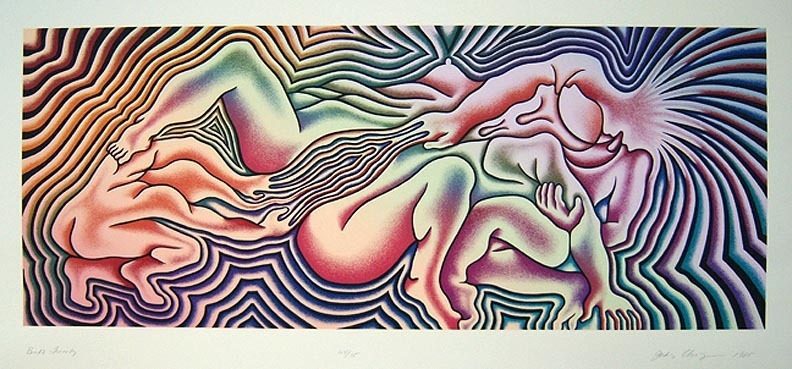Judy Chicago’s “Birth Trinity”
Birth Trinity, needlework tapestry (Copyright 1985, Judy Chicago. All Rights Reserved.)
As described in previous Visualizing Birth blogposts, American artist Judy Chicago’s Birth Project represents five years of work (1980-1985) devoted to the creation of birth images. After having noticed few images of birth present in all of Western art, Chicago decided to create some herself, and thus the Birth Project was born. Working along with Chicago, over 130 needleworkers contributed to the monumental project, creating needlepoint tapestries such as Earth Birth, Hatching the Universal Egg and The Crowning.
In Birth Trinity, the forms of three human figures merge, comprising the central composition. Rippled outlines surorund them in layers, all of which radiate towards the edge of the work. The largest figure is that of the birthing mother, from whose body emerges a smaller figure of her baby. The woman’s arms and much of her upper body are supported by a third figure, representative of a partner, caregiver or perhaps even symbolically of her own strength personified. The mother’s open birth passage radiates between all three figures, connecting them, while also mirroring the outlined ripples that radiate throughout the rest of the piece.
Pregnant women can utilize this artwork in the visualization of birth, meditating first on the magnitude of the piece and the sheer greatness that emanates from the scene depicted. The term “trinity” is often associated with the religious term in Christianity, “the Trinity,” a sacred union between God represented as three individual divinities: the Father, the Son and the Holy Spirit. Based on some of Chicago’s other work, namely her crowning achievement, Dinner Party, it is likely that Chicago is implying some significant greatness of the act of birth, comparable even to the sacred greatness found in some religious traditions. Regardless of the work’s actual meaning, there is a potency to Chicago’s image of birth, reminding the viewer that birth is a powerful, if not spiritual experience. Connecting herself to this universal thread of birth, the pregnant woman becomes empowered as she prepares to labor and undergo birth as a rite of passage.
Judy Chicago is an American artist known for her large-scale feminist installation pieces, which enage the viewer and explore the roles and treatment of women in history, art and culture. Her work is available widely across the internet, and more about her Birth Project may be seen here.
